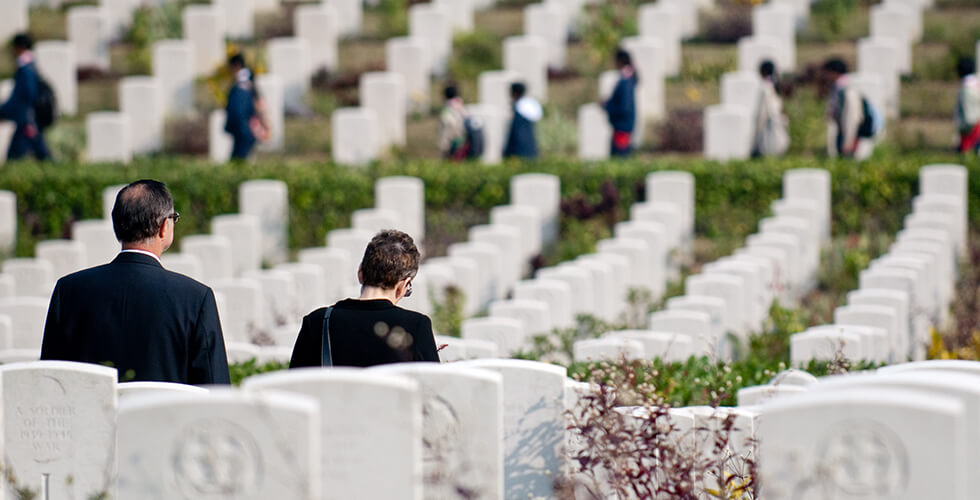11 March 2022
How to Find and Visit Indian War Dead from the World Wars
Did you know that the Commonwealth War Graves Commission commemorates more than 160,000 Indian casualties of the two world wars? You can find Indian war dead at CWGC cemeteries and memorials around the world. Find out more about how you can find them and discover more about their stories.

How to research and find Indian War Dead
Using the CWGC website to search for Indian war dead
The first place to go when researching war dead in India and around the world is the CWGC casualty records. Visit the CWGC website and select Find War Dead from the Find Records section.
This tool has a range of search parameters, but the easiest starting point when you’re looking for an Indian casualty, is to use the ‘Served with country’ dropdown menu to select all Indian soldiers. You can then use the rest of the search fields to refine your search.

Search by name
From the Find War Dead page, you can enter in a particular name and initials and run a search directly from there. We’ll then show you a list of exact matches to your search, close matches and then all matches, which show you all results that match at least one of the fields you’ve entered. You can then start refining your results to narrow down your search.
Indian war dead World War 1
If you are searching for WW1 servicemen, you can select First World War using the war selection options. This will limit the search to all service people who died between the Commission’s range of commemoration. For World War One this is 4 August 1914 to 31 August 1921.
Our How to Research… Undivided India is a great resource that will help you get started in your search.
Indian war dead World War 2
To find WW2 Indian casualties, you can use the war selection option to select all casualties that died during our World War Two commemoration window of 3 September 1939 to 31 December 1947.
 Using the CWGC mobile app to find war dead
Using the CWGC mobile app to find war dead
You can use the CWGC Find War Graves app to find out more about the war graves in your local area, or in an area you’re looking to visit.
When you load the app, you’ll be able to use your phone’s location information to find the nearby cemeteries in your area, or you can manually search for a specific location, or if you have a particular cemetery in mind, you can search for that too.
Once you have found the cemetery or memorial you’d like to learn more about, tap the More Info button to discover a list of the identified casualties there. As you would on the Find War Dead search, you can edit the search terms and find only Indian WW1 casualties, for example.
How to visit Indian war dead memorial sites
From the trench warfare of Europe, the harsh climates of Africa and the mountainous jungles of Asia, Indian soldiers served across almost every theatre of war in both conflicts, so those that made the ultimate sacrifice can be found at CWGC cemeteries and memorials across the world.
You can use the CWGC site to find war cemeteries and memorials across the globe. If you have a particular cemetery in mind you can search for it directly by name, or use the search fields to find a site in a particular location around the world.
Map view
If you want to get a clearer idea of the geography of the area, and the positions of our sites within a region by accessing our map view.
Once you’ve run your search, you can use the View as Map button at the top of the list - this will then show the results on a map, which you can then click on to get more details.
WW1 war memorials to Indian soldiers

Neuve-Chapelle Memorial
In March 1915, Indian Army forces took part in a large scale attack on the German lines which formed a salient, or bulge, around the village of Neuve-Chapelle. It was the largest British attack thus far in the war and Indian forces accounted for around one third of the attacking troops. Despite its limited gains and heavy losses, the battle demonstrated that the German trench defences could be breached, and future British attacks would draw on some of the lessons learned at Neuve-Chapelle.
Following the war, the officials of Undivided India elected to build a single memorial to all of the Indian missing from the conflict across the Western Front. Given its significance to the Indian Army, the memorial was erected at Neuve-Chapelle, France, and commemorates more than 4,700 soldiers and labourers of Undivided India who have no known grave.
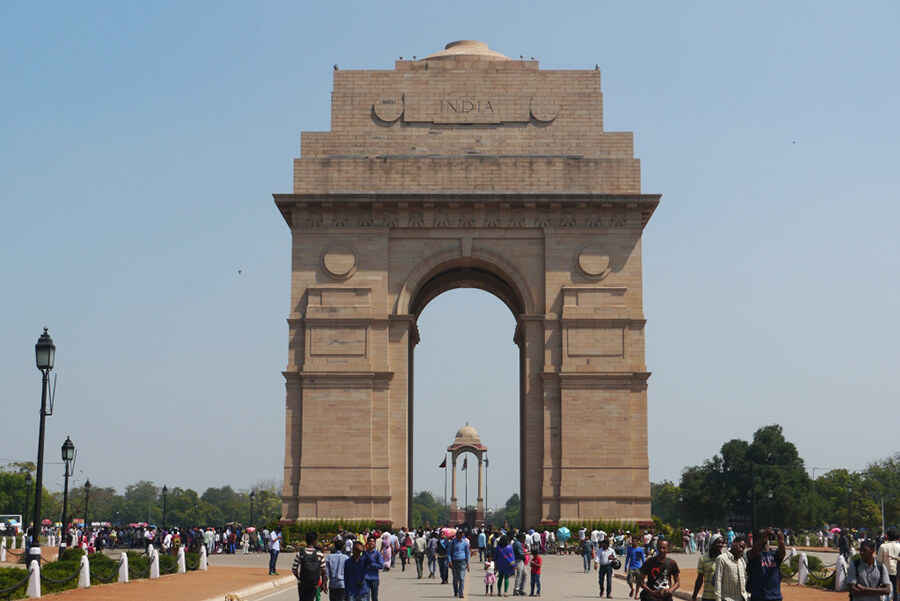
Delhi Memorial (India Gate)
The Delhi Memorial (India Gate) performs a dual purpose. Firstly, the memorial commemorates more than 13,000 Commonwealth servicemen who either have no known grave, or who’s graves were unmaintainable.
It also acts as a national memorial to the 70,000 servicemen of Undivided India who died between 1914 and 1921, many of whom are commemorated by name in cemeteries and memorials across the world. Like the Cenotaph for the UK, the India Gate plays a key role on important national days, and is part of India’s Republic Day parade.
Designed by Sir Edwin Lutyens, the memorial bears the inscription: “To the dead of the Indian Armies who fell and are honoured in France and Flanders, Mesopotamia and Persia, East Africa, Gallipoli and elsewhere in the near and the Far East and in sacred memory. Also of those whose names are here recorded and who fell in India on the North West frontier and during the Third Afghan War.”

Heliopolis (Port Tewfik) Memorial
The original Port Tewfik Memorial stood at the southern boundary of the Suez Canal. The canal itself was perhaps even more important during the world wars than it is today - linking the Mediterranean with the Red Sea and beyond, connecting Britain with its colonies in East Africa, Asia and the Pacific.
During World War One, it was a prime target for the Ottoman Empire, who launched several attacks towards the canal in 1915. These attacks were successfully repulsed, and the canal remained in British hands. British forces, including Australian, Indian and New Zealand units, would go on the offensive in late 1916 and by 1918 had captured large swaths of Ottoman territory in the Eastern Mediterranean.
Indian troops played a large part in the war in Egypt and the Eastern Mediterranean. In the 1920s the Port Tewfik memorial was built to commemorate the Indian servicemen who lost their lives in this theatre of war and who have no known grave. Unfortunately, during the Israeli-Egyptian conflict of 1967-73, the memorial suffered severe damage and was eventually demolished. A replacement memorial was later erected at Heliopolis War Cemetery and commemorates more than 3,700 Indian servicemen of World War One.
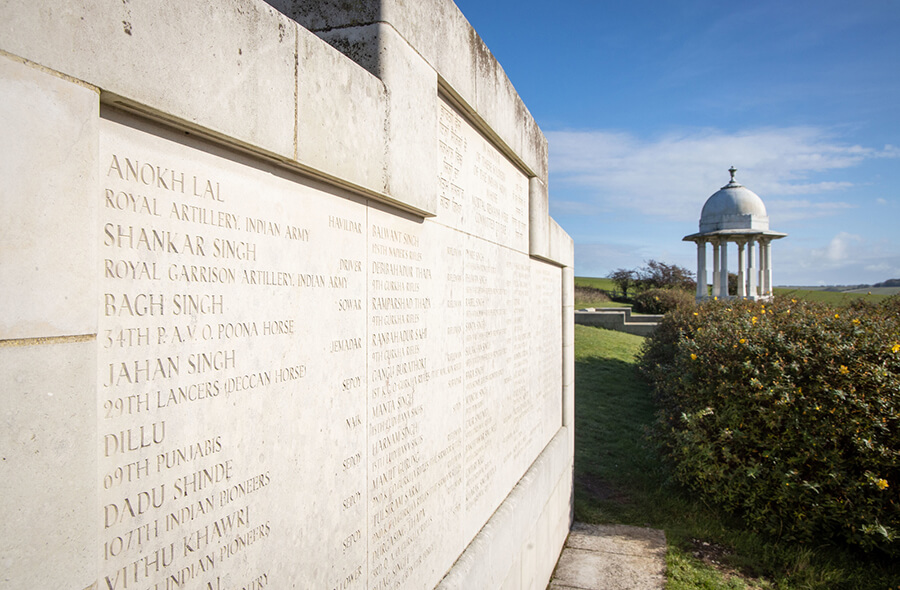
Patcham Down Memorial
This Patcham Down Indian Forces Cremation Memorial commemorates 53 Indian casualties of WW1 who died in the United Kingdom, many of them at the Indian Army hospital established at the Royal Pavilion in Brighton. These men were cremated in accordance with their faith and were initially commemorated on the Hollybrook and Neuve-Chappelle Memorials to the Missing. However, it was later decided that as these casualties were not ‘missing’ and therefore it would be better to commemorate them on a memorial at their cremation site. The memorial bears an inscription written in Hindi, Punjabi and English that reads: "IN HONOUR OF THESE SOLDIERS OF THE INDIAN ARMY WHOSE MORTAL REMAINS WERE COMMITTED TO FIRE"
WW2 war memorials to Indian soldiers
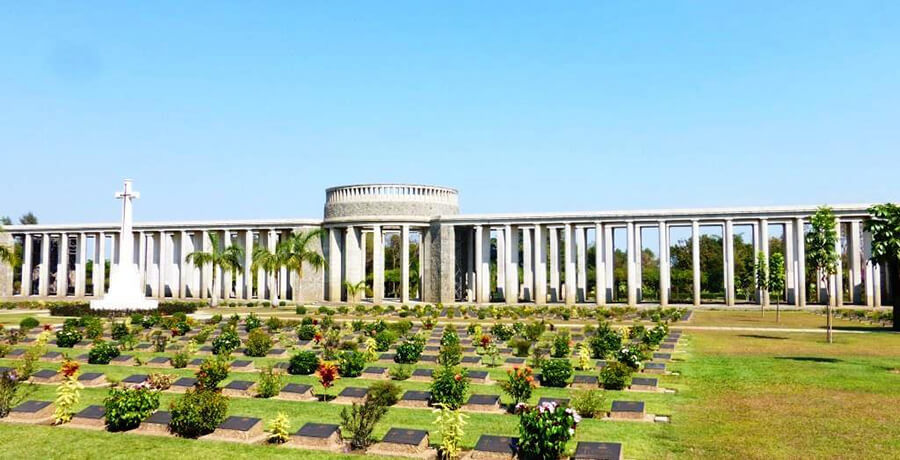
Rangoon Memorial
Located at the heart of Taukkyan War Cemetery, the Rangoon Memorial bears the names of more than 26,000 World War Two servicemen - almost 20,000 of them served with the Indian forces. The Taukyan Cremation Memorial commemorates a further 1,000 WW2 casualties whose remains were cremated in accordance with their faith.
The majority of these men were casualties of the campaign in Burma (now Myanmar). In 1942, in the face of the invading Japanese forces, the British Burma Army retreated from Burma into India. The country would remain under Japanese control until the winter of 1944/45, when a Commonwealth force returned to liberate the country from the Japanese.
A fierce campaign followed, culminating in a race to Rangoon, where Commonwealth troops hurried to secure the vital port before monsoon season set in. Within the week of the recapture of Rangoon, Germany formally surrendered to the Allies - and with Japanese influence in Burma all but eradicated, the end of the war was in sight.

Alamein Memorial
The two battles of El Alamein are arguably one of the key turning points of World War Two. Not only did they mark one of the first major Allied successes of the war, but they were the first step towards eventual victory in the North African campaign - which in turn was vital for the securing control of the Mediterranean.
At times during the conflict the desert was as much an enemy as the opposing troops. Swelting days and freezing nights in a vast bleak desert, which meant supply lines could be precariously long, and populated by biting flies.
Of the more than 11,000 casualties commemorated on the Alamein memorial, over 1,800 of them served with Indian forces, who fought in campaigns across North Africa and the Eastern Mediterranean. A further 600 Indian casualties are listed on the Alamein Cremation Memorial as their remains were cremated during the war, in accordance with their faith.
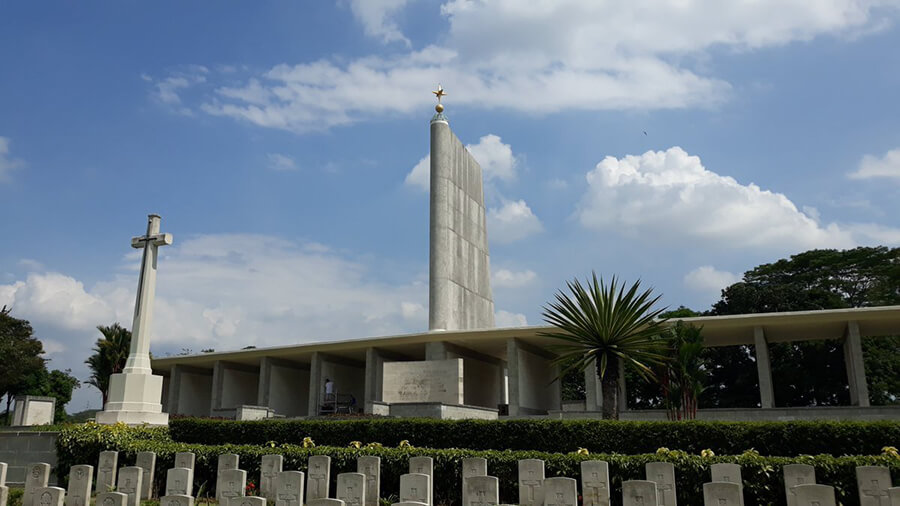
Singapore Memorial
Japanese forces launched a devastating surprise attack against British Malaya (Malaysia) in December 1942. British and Commonwealth forces where quickly driven back down the peninsular and by February had retreated across the straits to Singapore. Japanese forces besieged the island on 15 February Singapore island, the key stone of British imperial defence in southeast Asia, fell and some 80,000 Commonwealth troops became prisoners of war.
The Singapore Memorial commemorates more than 24,000 Commonwealth casualties - more than 12,000 of whom are Indian. Some of the those commemorated here died during the defence of Malaya and Singapore, but most died while in captivity as a result of brutal treatment by the Japanese.
There is also the Singapore Cremation Memorial, which commemorates almost 800 casualties, mostly Indian forces, who were cremated in accordance with their religious beliefs.
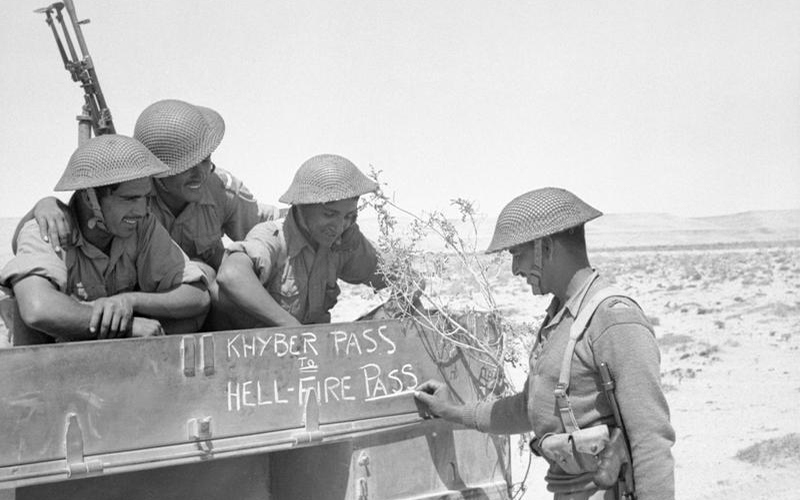
Indian soldiers in WW2. IWM (E 3660)
How were Indian personnel commemorated?
Do Indian personnel have war graves?
The men and women who served in the armed forces of Undivided India came from a wider range of ethic, cultural and religious backgrounds.
When the Commission came to commemorate these servicemen, particular care had to be taken to ensure that were possible each individual was commemorated according to his or her beliefs. This meant that while some Indian service people could be buried in a CWGC cemetery, others were cremated, and alternative forms of commemoration had to be devised.
Commemoration and race
Cremating servicemen and women in accordance with their religious preferences posed a question about commemoration. Without a body to bury there could be no headstone, but it wouldn’t be correct to say that the casualty was missing either.
During the First World War those Indian servicemen who were cremated where for the most part commemorated on memorials to missing, such as at Neuve Chapelle. However, following the Second World War it was felt this was no longer appropriate. Instead, dedicated cremation memorials were placed in cemeteries where the names of those who were cremated could be commemorated alongside those who were buried - uniting them in death as they had been in life.
Two of the largest cremation memorials are at Taukkyan and Kohima.
The Taukkyan Cremation Memorial commemorates more than 1,000 casualties of the Burma campaign who were cremated in accordance with their faith. It stands in Taukkyan War Cemetery, the largest of the three cemeteries in Burma.
In Kohima War Cemetery, the Kohima Cremation Memorial commemorates 917 soldiers many of whom died defending against the Japanese invasion of India, from Burma, in 1944.
India and the two World Wars
The contributions of the Indian personnel during both wars cannot be overlooked. Not only was the huge amounts of manpower and resources that came from India vital during both conflicts, but, as Churchill said, the “unsurpassed bravery of Indian soldiers and officers” was a key factor in the eventual victories.
How was India involved in the Great War?
More than one million members of the Indian armed forces served overseas during World War One.
Indian troops served on the Western Front most famously at the Neuve Chapelle. But also served in many other theatres of the war, in Egypt and the eastern Mediterranean, in East Africa, Gallipoli, across the Middle East.
Stories of Indian soldiers in World War 1
Khudadad Khan
One of the most famous Indian soldiers of the war is Khudadad Khan, who was the first Indian recipient of the Victoria Cross in World War One. Khan was serving in the Hollebeke sector of the line during the First Battle of Ypres. He was part of a desperate defensive action against an overwhelming German attack, manning a machine gun and helping to prevent a German breakthrough. The London Gazette reports that Khan, “though himself wounded, remained working his gun until all the other five men of the gun detachment had been killed.” This rear-guard action helped delay the German advance long enough for reinforcements to arrive, preventing a breakthrough and stopping the Germans from reaching the vital channel ports.
Gabar Singh Negi
Another Indian Victoria Cross winner from World War One is Gabar Singh Negi, who fought in one of the major Indian actions of the war: the battle of Neuve-Chapelle. As part of the attack, serval groups were tasked with moving from trench to trench armed with bayonets and bombs to clear out the defenders. When Negi’s commander was killed, he took up the lead, the Gazette reports: “During our attack on the German position he was one of a bayonet party with bombs who entered their main trench, and was the first man to go round each traverse, driving back the enemy until they were eventually forced to surrender.” Negi was eventually killed during the battle, and his Victoria Cross awarded posthumously. He is commemorated on the Neuve-Chapelle memorial.
How many Indian soldiers died in World War 1?
We commemorate more than 73,000 Indian servicemen from World War One, around 8,000 of whom are buried in one of our cemeteries while 65,000 are commemorated on one of our memorials.

A group of British and Indian soldiers during World War One. IWM Q 52695
How was India involved in World War 2?
Japan’s expansion during the war brought the conflict to India’s doorstep. While the battles of Imphal and Kohima were hugely important in stopping the Japanese advance into India itself, the Indian forces were vital across the Southeast Asian theatre, fighting in the defence of Malaya and Singapore, as well as the defence and recapture of Burma.
As in World War One, Indian forces played key roles across Africa and the Middle East. Prime examples are actions in North Africa, where Indian forces were key in the fight against Rommel’s Afrika Korps, including at the battles of El Alamein.
Indian troops also played a key role in the Anglo-Iraqi war, where Allied forces fought to remove a government sympathetic to the Germans and Italians, and in securing Persian (modern day Iran) oilfields, as well as ensuring that vital supply lines with the Soviet Union remained viable.
Indian soldiers in World War 2
Abdul Hafiz
Naib Subedar Abdul Hafiz died aged just 18 years old. During the Battle of Imphal, charged with leading an attack on a fortified enemy position, Hafiz personally led the attack despite injury during the initial assault. Hafiz had whipped his troops up into a frenzy and led his attack with such ferocity that the defending soldiers were forced back despite a numerical advantage. While trying to press the advantage his attack had given, Hafiz was fatally wounded. For his inspirational leadership and bravery, Hafiz was awarded the Victoria Cross. He is buried at Imphal Indian Army War Cemetery.
Richhpal Ram
During an assault on enemy positions near Keren, Eritrea, Subadar Richhpal Ram assumed command of his company after his commander had been wounded. Once he’d captured his objectives, Ram led his company in defence of six enemy counter attacks, only retreating once his ammunition had been exhausted. A few days later, he led another attack, receiving ultimately fatal wounds. Even when injured, he was reported to be an inspirational presence to his men, encouraging the attack to continue. Ram was awarded the Victoria Cross for his “heroism, determination and devotion to duty” and is commemorated on Keren Cremation Memorial.
How many Indian soldiers died in World War 2?
CWGC commemorates more than 87,000 Indian service people who died during the Second World War, about 18,000 are buried at a CWGC cemetery and 68,000 are commemorated on memorials around the world.
Discover war dead records from around the world
Discover the war records of all of the Indian armed forces we commemorate, as well as the rest of the 1.7 million men and women of the Commonwealth who died during the world wars.
